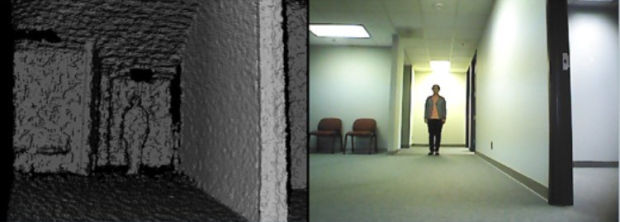In case you missed it last week, Orbbec Technology Corp of Shenzhen, China showed up at this year’s Display Week with a new 3D camera computer and its focus on 3D Sensing, Artificial Intelligence, RGB-D Recognition, and Natural User Interface. The technology offers a very wide sensitivity range (0.4m – 8m) with depth image size of 640 x 480 and an HD RGB image size of 1280 x 720, both at 30 fps, with a field of view of 73D x 60H x 49.5V. The technology is intended to support gesture control, robotics, 3D scanning, and should empower new areas, impossible until now.

Mainland China-based Orbbec Technology Corp has a US office in Troy, MI, and the company found its way through a strict committee selection process and into the iZone (short for Innovation Zone) section of the SID Display Week expo show floor. iZone, offers start-ups and labs a place for prototypes to show new stuff, well before it becomes a commercial shipping product. This unique version of 3D camera technology is described by Business Development Manager Agnes Zheng as offering higher accuracy, lower power and easier connectivity to more operating systems than the Connect II, its rival (groundbreaking) device from Microsoft.
Color (lt) vs non-color 3D camera image captured for shape recognition, source: CompanyThe Orbbec Persee 3D camera computer is designed to plug into a TV/monitor, and can even run without a display with direct interaction through the built-in 3D camera with depth measurement accuracy and shape recognition based on color perception. Zheng said, “Its ability to see, hear, and understand makes it much smarter than a regular computer. And its powerful built-in ARM processor makes it much more useful than single-use devices”.
 Computer vision that is closer to human perception offers many advantages including using color to discern objects, 3D depth etc. source: CompanyZheng spoke to us from the iZone show floor and told us she has a Masters in mechanical engineering and specialized in optical measurement. She was part of the group that spun out of a University research project with its IR laser sensor technology, and claims this approach can better measure objects at 1 meter with accuracy levels at 1-3 mm in size and distance to the object.
Computer vision that is closer to human perception offers many advantages including using color to discern objects, 3D depth etc. source: CompanyZheng spoke to us from the iZone show floor and told us she has a Masters in mechanical engineering and specialized in optical measurement. She was part of the group that spun out of a University research project with its IR laser sensor technology, and claims this approach can better measure objects at 1 meter with accuracy levels at 1-3 mm in size and distance to the object.
“The laser sensor we use has a narrow bandwidth laser light that does not get absorbed by dark surfaces. We designed it in-house and have it specially made for this product,” Zheng said. They also added an improved bandwidth filter and improved algorithms and these contribute to the higher accuracy performance.
The group adds support for not just Windows, (Its Windows exclusively on the Connect II) but support Android and Unix platform development as well. The group also will sell an OEM module for individual product design projects and integration into multiple devices including LCD and OLED based TVs. Power is another advantage over the popular MS Connect II as the Orbbec 3D camera runs from a standard USB2 connection with 1.8W maximum draw, far lower than the MS 5.0 W requirement.
The retail version of the product is $150 and requires no power adapter, putting the Orbbec at parity with Connect II when the price of the external power adapter is added on to its $99 price.
Microsoft moved to a time of flight (ToF) model in the Connect II, while Orbbec is using a unique dot pattern that the company designed using the structured light approach. Zheng told us they have world wide patents on this technology.
Meanwhile back in the iZone, users had a blast using motion detection to control the Sony HD flatscreen, playing real-time games and showing off just how accurate the technology can be. So, get ready for a new wave of gesture based recognition technology based more closely on how humans perceive reality.
– Steve Sechrist

